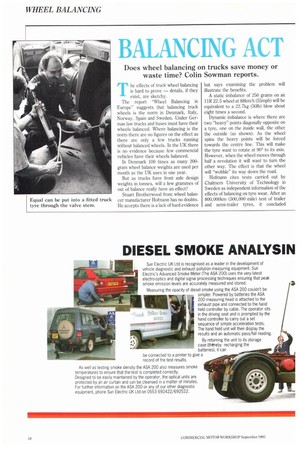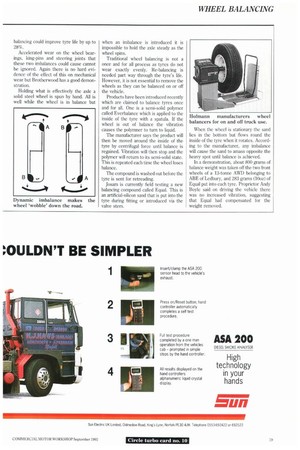BALANCING ACT
Page 94

Page 95

If you've noticed an error in this article please click here to report it so we can fix it.
Does wheel balancing on trucks save money or waste time? Colin Sowman reports.
The effects of truck wheel balancing is hard to prove — details, if they exist, are sketchy. The report "Wheel Balancing in Europe" suggests that balancing truck wheels is the norm in Denmark, Italy, Norway, Spain and Sweden. Under German law trucks and buses must have their wheels balanced. Where balancing is the norm there are no figures on the effect as there are only a few trucks running without balanced wheels. In the UK there is no evidence because few commencial vehicles have their wheels balanced.
In Denmark 100 times as many 200gram wheel balance weights are used per month as the UK uses in one year.
But as trucks have front axle design weights in tonnes, will a few grammes of out of balance really have an effect?
Stuart Brotherwood from wheel balancer manufacturer Hofmann has no doubts. He accepts there is a lack of hard evidence but says examining the problem will illustrate the benefits.
A static imbalance of 250 grams on an 11R 22.5 wheel at 88krali (55mph) will be equivalent to a 22.7kg (50lb) blow about eight times a second.
Dynamic imbalance is where there are two "heavy" points diagonally opposite on a tyre, one on the inside wall, the other the outside (as shown). As the wheel spins the heavy points will be forced towards the centre line. This will make the tyre want to rotate at 90° to its axis. However, when the wheel moves through half a revolution it will want to turn the other way. The effect is that the wheel will "wobble" its way down the road.
Hofmann cites tests carried out by Chalmers University of Technology in Sweden as independent information of the effects of balancing on tyre wear. After an 800,000km (500,000 mile) test of trailer and semi-trailer tyres, it concluded balancing could improve tyre life by up to 28%.
Accelerated wear on the wheel bearings, king-pins and steering joints that these two imbalances could cause cannot be ignored. Again there is no hard evidence of the effect of this on mechanical wear but Brotherwood has a good demonstration.
Holding what is effectively the axle a solid steel wheel is spun by hand. All is well while the wheel is in balance but when an imbalance is introduced it is impossible to hold the axle steady as the wheel spins.
Traditional wheel balancing is not a once and for all process as tyres do not wear exactly evenly. Re-balancing is needed part way through the tyre's life. However, it is not essential to remove the wheels as they can be balanced on or off the vehicle.
Products have been introduced recently which are claimed to balance tyres once and for all. One is a semi-solid polymer called Everbalance which is applied to the inside of the tyre with a spatula. lithe wheel is out of balance the vibration causes the polymer to turn to liquid.
The manufacturer says the product will then be moved around the inside of the tyre by centrifugal force until balance is regained. Vibration will then stop and the polymer will return to its semi-solid state. This is repeated each time the wheel loses balance.
The compound is washed out before the tyre is sent for retreading.
Josam is currently field testing a new balancing compound called Equal. This is an artificial-silicon sand that is put into the tyre during fitting or introduced via the valve stem. When the wheel is stationary the sand lies in the bottom but flows round the inside of the tyre when it rotates. According to the manufacturer, any imbalance will cause the sand to amass opposite the heavy spot until balance is achieved.
In a demonstration, about 800 grams of balance weight was taken off the two front wheels of a 13-tonne AWD belonging to ABE of Ledbury, and 283 grams (10oz) of Equal put into each tyre. Proprietor Andy Boyle said on driving the vehicle there was no increased vibration, suggesting that Equal had compensated for the weight removed.




































































































